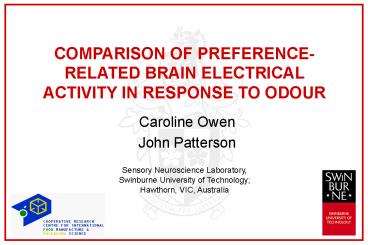Caroline Owen - PowerPoint PPT Presentation
1 / 19
Title:
Caroline Owen
Description:
Dislike smaller negative peak at 200-225 ms LF cf RF; larger ... Dislike response associated with larger amplitudes and latency differences cf Like response ... – PowerPoint PPT presentation
Number of Views:71
Avg rating:3.0/5.0
Title: Caroline Owen
1
COMPARISON OF PREFERENCE-RELATED BRAIN ELECTRICAL
ACTIVITY IN RESPONSE TO ODOUR
Caroline Owen John Patterson
Sensory Neuroscience Laboratory, Swinburne
University of Technology Hawthorn, VIC, Australia
2
Introduction
- Changes in brain electrical activity associated
with physiological responses to an odour
independent of subjective detection - Changes in responses between different odours and
associated with reported preference or hedonic
responses to the odours - To further investigate these differences in
responses - Subjective responses correlated with objective
physiological responses - To investigate differences in perceptual
responses to a low concentration odour delivered
during natural respiration.
3
Continuous Respiration Olfactometer
3. Odour delivery syringe system
air/odour delivery
1. Respiratory facemask
syringe motor drive output
2. Serial interface device
respiratory information
input to pressure transducer
Sensory Neuroscience Laboratory
4
EGI and CRO Recording System
Sensory Neuroscience Laboratory
5
Method
- Test odour D-limonene (citrus sweet orange lemon
odour) - Odour and air delivered at pseudo random ratio of
13, synchronised with natural inspiration - 4 repeated recording sessions total of 20
minutes per subject - 16 screened subjects (8 m, 8 f), non-smokers,
right handed - Mean age 23.4 years ( 6.6), range 18 - 40
years - Normal range of olfactory ability (Sniffin
Sticks) - Mean TDI score 34.53, range 30.75 - 40.5
- Like Group n 13 Mean preference 2.17
0.6 - Dislike Group n 3 Mean preference 6.34
0.54
6
Results Like - Left Frontal Odour vs Air
Amplitude Scale equates to 5 µV
Sensory Neuroscience Laboratory
7
Results Dislike - Left Frontal Odour vs Air
Amplitude Scale equates to 5 µV
Sensory Neuroscience Laboratory
8
Results Like - Right Frontal Odour vs Air
Amplitude Scale equates to 5 µV
Sensory Neuroscience Laboratory
9
Results Dislike - Right Frontal Odour vs Air
Amplitude Scale equates to 5 µV
Sensory Neuroscience Laboratory
10
Results Like vs Dislike - Left Frontal
Amplitude Scale equates to 5 µV
Sensory Neuroscience Laboratory
11
Results Like vs Dislike - Right Frontal
Amplitude Scale equates to 5 µV
Sensory Neuroscience Laboratory
12
Results Right Temporal - Air vs Odour
Amplitude Scale equates to 5 µV
Sensory Neuroscience Laboratory
13
Results Left Temporal Air vs odour
Amplitude Scale equates to 5 µV
Sensory Neuroscience Laboratory
14
Results Topographic Mapping
220 ms post-stimulus
15
Results Power Spectrum
16
Results Power Spectrum 2
Sensory Neuroscience Laboratory
17
Discussion
- Amplitude Dislike larger amplitudes than Like
- Dislike smaller negative peak at 200-225 ms LF cf
RF larger positive peak at 400 ms LF cf RF - Latency Delay in negative peak for Dislike cf
Like - Dislike negative peak at 200-225 ms
- Like negative peak at 150-175 ms
- Power Spectrum Frequency differences cf
preference group - Large hemispheric differences 4-7 Hz for both
groups - Like Stronger LF cf RF odour differences 4-7
8-12 Hz - Dislike Stronger RF cf LF odour differences 8-12
13-17Hz - Large differences 13-17 Hz for Dislike group cf
Like group
18
Conclusion
- Differences in electrophysiological activation of
odour cf air associated with the preference
response - Differences in LF RF early responses
(pre-450ms) - Comparative air responses with each group
- Dislike response associated with larger
amplitudes and latency differences cf Like
response - Possible reflection of odour preference in
differences in frequency responses - Potential as method for quantifying
electrophysiological responses to low
concentration odour during natural respiration,
independent of subjective reporting
19
Acknowledgements
CRC for International Food Manufacture
Packaging Science Dairy Research Development
Corporation Bonlac Foods Ltd Dr Peter Cadusch
Dr Mark Schier Simon Danckert































